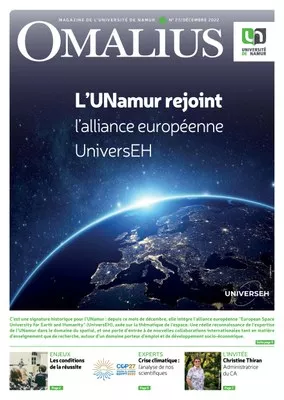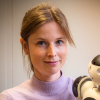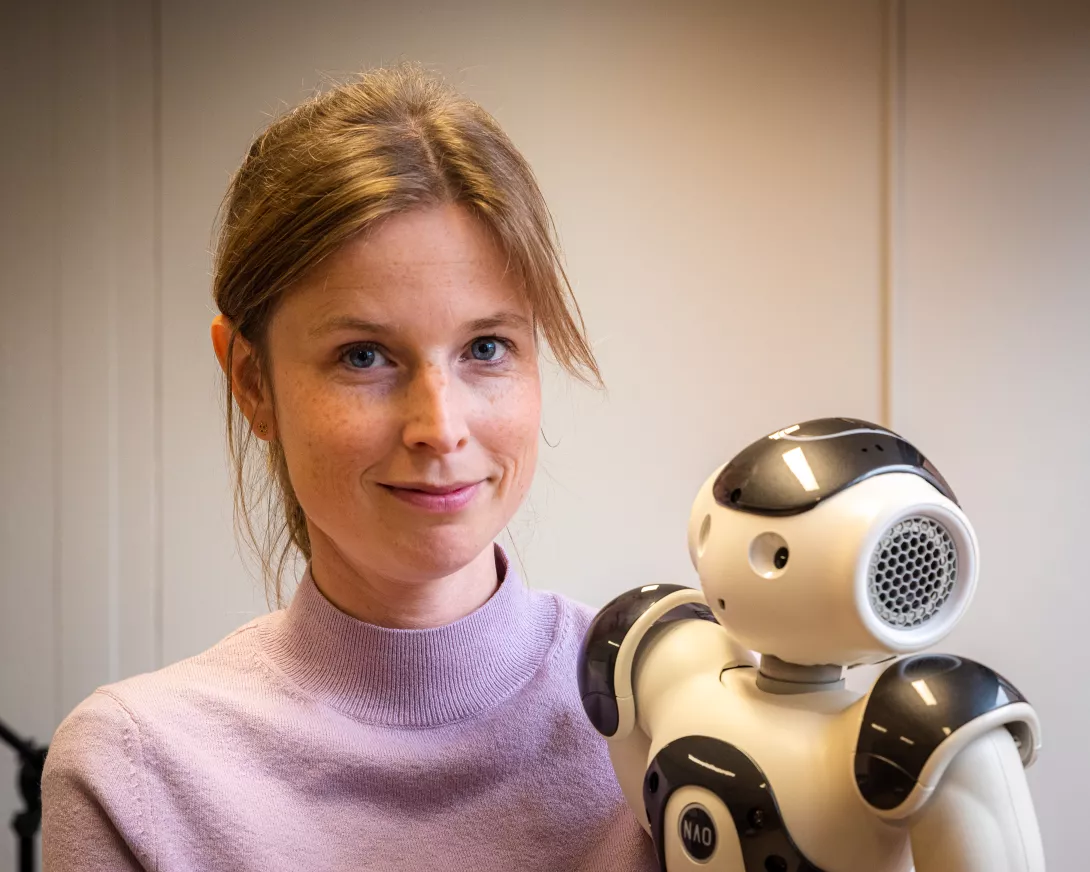
This interview was conducted for the "Expert" section of Omalius magazine #27 (December 2022)
After an atypical curriculum (see CV express below), her meeting with Luc Steels (VUB), a pioneer of artificial intelligence in Europe and an expert in evolutionary computational linguistics, and an international experience as a student and post-doctoral researcher, Katrien Beuls has just moved to UNamur.
"A position as 'Lecturer in Artificial Intelligence' was vacant. I applied and here I am! I found it interesting that the job description did not restrict the function to a specific sub-field of AI. I find UNamur extraordinary, because of the human size of the institution, which allows for a lot of interaction quickly, as you get to know everyone quickly! I also had the impression that there was a certain open-mindedness in the Faculty of Computer Science and that they were interested in new methodologies. I really feel that UNamur is an excellent place to create my own interdisciplinary research team.
A passionate researcher
"I am trying to build intelligent systems, so-called cognitive agents that implement the 'perceive', 'reason', 'act' cycle that constitutes the decision process. These intelligent agents have to solve communication tasks in teams. The aim is to build a common language to refer to a situation, objects, etc. This is done in the form of a game according to an established protocol. An agent chooses a topic of conversation and has to ask himself the question: what do I have to say so that the other knows what I am talking about? They have perceptual abilities but see the world or segments of it without labels and have no language system.
This is a bit like how a child learns a language. At the beginning, he has no vocabulary and does not know grammar. They have to learn to relate what they see to the word or concept that defines it. This is a process that involves many cognitive abilities, at the sensorimotor, conceptual and linguistic levels. Human beings are the only ones who can express themselves through a constructed language. This is a great source of inspiration.
New dynamic systems: learning and adaptating
Let's take a first game. Several agents are faced with the same scene (see opposite). The first agent wants to point to the red teddy bear and calls it 'it'. But multiple factors are linked to this information: the location in space, the material, the colour... A mechanism will store the information and classify it. The term "it" is too vague, there are several possible interpretations. Is it the plush? Its colour? To solve this chaos, another mechanism is introduced to manage the problems of association between shape and meaning: a score between 0 and 1 is added (1 means a good association, 0 a bad one). As interactions with multiple agents take place, the scores will increase or decrease. This makes it possible to verify the correct understanding and the choice of a precise common term. But we are only dealing here with basic lexical terms: vocabulary words. We also need to introduce grammar.
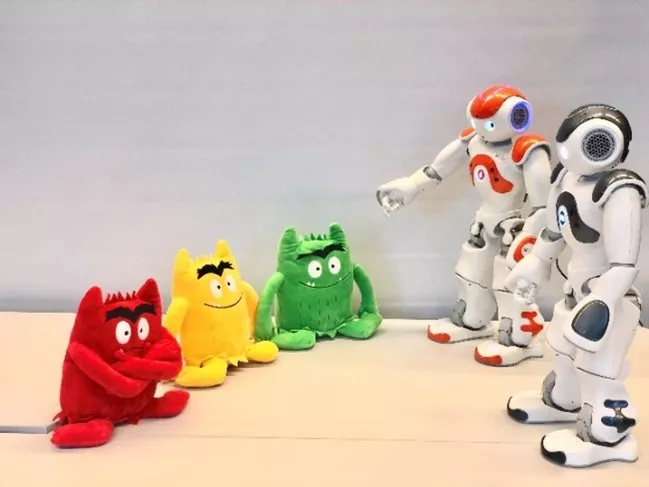
In order to move towards more complex structures on a semantic and conceptual level, we will have to push the experiment further. The red plush toy is already a complex concept: its material (furry fabric), its shape (small monster), its colour (in RGB form), its location in space (to the left, next to, etc.), its size (small, large), etc. All these concepts will have to be isolated. Compare red objects, for example, in order to be sure that we are talking about colour. In this way, we can refine our understanding until a common term is identified and accepted.
"The AI method for the language game I am working on involves a multitude of agents that will introduce many ideas and concepts in order to finally find a common language and thus a robust, adaptive and productive communication protocol."
Language: a layer of abstraction about the world and its understanding
Let's go back to humans and two of the fundamental capacities in language acquisition: reading intention and finding patterns. According to the theory of construction grammar, all of a language user's knowledge is composed of constructions, i.e. associations between form and meaning.
"Take a young child who is asked, 'Would you like some more milk? Depending on his reaction, he may or may not get any. It is from this interaction that the child can make a hypothesis about the meaning of the sentence he or she has heard: he or she "reads" the intention of the speaker in the given context. By dint of repetition, the child consolidates this question, the compositional structure of which he is still unable to understand. He also adapts over time. Do you want some more water? And the process repeats itself. Thanks to the pattern-seeking mechanism, he will come to the following conclusion: Do you want X? I get X."
Intent reading is complicated to implement when it comes to AI because it refers to the ability to hypothesize the intended meaning of an observed utterance based on the situational context in which it is uttered. Pattern matching refers to the ability to generalize about pairs of observed statements and their hypothesized meaning, producing form-meaning mappings of varying degrees of abstraction.
We create algorithms starting from an inventory of basic operations to develop programs that will allow the construction of conceptual structures in an intent reading mode. For an agent, the process will be as follows to answer a question such as "How many blue cubes are there in the image?" Colour alone is a complex concept as a robot reads it in RGB mode. Green can be mistaken for blue without checking that the nuances have been correctly understood.
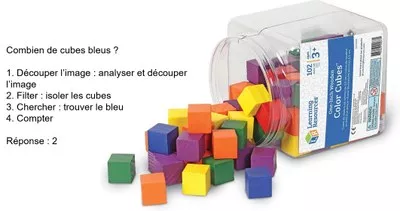
By dint of repetition and interaction with other agents, and with a precise goal, it will consolidate the different concepts it has encountered by calling on all its memory and associating the elements with each other. This will create a holistic expression in which it can construct meaning.
Deliberative intelligence
The book "Thinking, fast and slow", written in 2011 by psychologist Daniel Kahneman explains the dichotomy between two modes of thinking: 'System 1' is fast, instinctive and emotional and 'System 2' is slower, more deliberative and logical. System 1 is basic. System 2 is reflective and reasoned.
"The AI world is currently based on a reactive intelligence system. I am trying to implement deliberative intelligence. One of the major limitations of most current AI systems is that they learn to solve a single task based on millions of examples. This is not intelligence. Having segmented knowledge is absurd! Intelligence is about solving new problems and adapting to the knowledge you already have.
In addition to teaching and supervising ongoing research projects, Katrien regularly organises interdisciplinary workshops with linguists, psychologists and biologists for inspiration.
Express CV
- 2008: Master's degree in Language and Literature (English/Spanish) at the KU Leuven
- 2009: Master in Speech and Language Processing at the University of Edinburgh
- 2010-2014: PhD in Computer Science at the VUB under the supervision of Professor Luc Steels, founder of AI in Belgium. IWT scholarship (equivalent to FRIA in Flanders).
- 2014: Post-doctoral researcher at the International Computer Science Institute (ICSI) in Berkeley and leader of several EU projects at VUB (Atlantis, ODYCCEUS, AI4EU)
- 2014-2022: Visiting Professor in the Computer Science Department at the VUB
- Since April 2022: Lecturer at UNamur.
Ongoing projects
- The research institute BEEHAIF (Belgian Evolutionary and Hybrid AI Foundation), of which she is co-founder, is an association of researchers in the field of evolutionary and hybrid AI in Belgium. Workshops are regularly organised.
- Meaning and understanding in Human-centric AI (MUHAI)- A robot that cooks in virtual reality. Modelling everyday activities such as preparing a meal and developing systems that can understand instructions in "human" language (which are often very imprecise) in order to execute all the steps of a recipe and arrive at a well-prepared meal. A 'recipe execution benchmark' was developed to test the system and compare it to alternative techniques.
- Language games for ontology alignment under partial observability', Alexane Jouglar, co-supervised with Prof. dr. Anthony Cleve in the ARIAC project. In this project, the language game paradigm is used to develop a common language for exchanging information that is stored in different databases.
- A demo in development for the Printemps des sciences 2023 (March 20-26, 2023): build a language to name colours with a robot, see what happens when it has stored an information. Summary: "Have you ever wondered if a robot sees as many colours as you do? And are they the same? Take part in our interactive demonstration and create a language to communicate about colours with our robot. Then you can take home a postcard with your newly created language."
